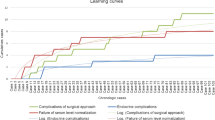Abstract
Purpose
The indications for and the optimal biopsy approach in pituitary stalk-hypothalamic (PsH) lesions are controversial. Biopsies through an endoscopic endonasal approach (EEA) for PsH lesions have often been considered to cause the infundibulo-tuberal syndrome. The purpose of this study was to analyze the surgical and endocrinological safety of EEA biopsies for PsH lesions.
Methods
A total of 39 consecutive patients who underwent an EEA biopsy between June 2011 and August 2020 in a single institute were retrospectively analyzed. The ophthalmological and endocrinological outcomes were assessed before and after surgery.
Results
PsH lesions were confirmed to be diverse pathological diagnoses, ranging from lymphocytic hypophysitis to diffuse midline glioma, and the most common pathologic diagnosis was a germinoma (18 patients, 46.2%). No patients developed visual deterioration after the biopsy. In patients without preoperative panhypopituitarism, 13 out of 28 patients (46.4%) developed new anterior pituitary hormonal deficiencies after the biopsy. When the tissue was collected from the stalk, the endocrinological deterioration rate was 100% (6 of 6 patients), while the rate was 31.8% (7 of 22 patients) when tissue could be harvested from an extra-stalk lesion. The rate of newly developed permanent diabetes insipidus after surgery was 40.9% (9 of 22 patients). The median surgery time was 125 min, and there was no postoperative CSF leakage or infections noted.
Conclusions
An EEA biopsy for PsH lesions is a safe and efficient surgical method unless the tissue is collected from the stalk.


Similar content being viewed by others
Data availability
The datasets generated during and/or analyzed during the current study are available from the corresponding author on reasonable request.
Code availability
Not applicable.
References
Hamilton BE, Salzman KL, Osborn AG (2007) Anatomic and pathologic spectrum of pituitary infundibulum lesions. Am J Roentgenol 188(3):W223–W232. https://doi.org/10.2214/ajr.05.2027
Jinguji S, Nishiyama K, Yoshimura J, Yoneoka Y, Harada A, Sano M et al (2013) Endoscopic biopsies of lesions associated with a thickened pituitary stalk. Acta Neurochir 155(1):119–124. https://doi.org/10.1007/s00701-012-1543-6
Turcu AF, Erickson BJ, Lin E, Guadalix S, Schwartz K, Scheithauer BW et al (2013) Pituitary stalk lesions: The Mayo Clinic experience. J Clin Endocrinol Metab 98(5):1812–1818. https://doi.org/10.1210/jc.2012-4171
Jian F, Bian L, Sun S, Yang J, Chen X, Chen Y et al (2014) Surgical biopsies in patients with central diabetes insipidus and thickened pituitary stalks. Endocrine 47(1):325–335. https://doi.org/10.1007/s12020-014-0184-3
Catford S, Wang YY, Wong R (2016) Pituitary stalk lesions: systematic review and clinical guidance. Clin Endocrinol 85(4):507–521. https://doi.org/10.1111/cen.13058
Todeschi J, Chibbaro S, Clavier J-B, Lhermitte B, Goichot B, Proust F (2016) An unusual pituitary stalk lesion: What is the place of surgery? Neurochirurgie 62(6):339–343. https://doi.org/10.1016/j.neuchi.2016.08.002
Kinoshita Y, Yamasaki F, Tominaga A, Usui S, Arita K, Sakoguchi T et al (2017) Transsphenoidal posterior pituitary lobe biopsy in patients with neurohypophysial lesions. World Neurosurg 99:543–547. https://doi.org/10.1016/j.wneu.2016.12.080
Carrasco-Moro R, Castro-Dufourny I, Prieto R, Pascual JM (2018) Transphenoidal surgery: the optimal approach to chordoid gliomas of the third ventricle? J Korean Neurosurg Soc 61(6):774–776. https://doi.org/10.3340/jkns.2017.0221
Komotar RJ, Starke RM, Raper DMS, Anand VK, Schwartz TH (2012) Endoscopic endonasal compared with microscopic transsphenoidal and open transcranial resection of giant pituitary adenomas. Pituitary 15(2):150–159. https://doi.org/10.1007/s11102-011-0359-3
Koutourousiou M, Gardner PA, Fernandez-Miranda JC, Paluzzi A, Wang EW, Snyderman CH (2013) Endoscopic endonasal surgery for giant pituitary adenomas: advantages and limitations. J Neurosurg 118(3):621–631. https://doi.org/10.3171/2012.11.jns121190
Kim JH, Lee JH, Lee JH, Hong AR, Kim YJ, Kim YH (2018) Endoscopic transsphenoidal surgery outcomes in 331 nonfunctioning pituitary adenoma cases after a single surgeon learning curve. World Neurosurg 109:e409–e416. https://doi.org/10.1016/j.wneu.2017.09.194
Kim Y-H, Kang H, Dho Y-S, Hwang K, Joo J-D, Kim YH (2021) Multi-layer onlay graft using hydroxyapatite cement placement without cerebrospinal fluid diversion for endoscopic skull base reconstruction. J Korean Neurosurg Soc 64(4):619–630. https://doi.org/10.3340/jkns.2020.0231
Czernichow P, Garel C, Léger J (2000) Thickened pituitary stalk on magnetic resonance imaging in children with central diabetes insipidus. Horm Res Paediatr 53(3):61–64. https://doi.org/10.1159/000023536
Lee JY, Park JE, Shim WH, Jung SC, Choi CG, Kim SJ et al (2017) Joint approach based on clinical and imaging features to distinguish non-neoplastic from neoplastic pituitary stalk lesions. PLoS ONE 12(11):e0187989. https://doi.org/10.1371/journal.pone.0187989
Kang J-M, Ha J, Hong EK, Ju HY, Park BK, Shin S-H et al (2019) A nationwide, population-based epidemiologic study of childhood brain tumors in korea, 2005–2014: a comparison with United States Data. Cancer Epidemiol Biomark Prev 28(2):409–416. https://doi.org/10.1158/1055-9965.epi-18-0634
Wong TT, Ho DM, Chang KP, Yen SH, Guo WY, Chang FC et al (2005) Primary pediatric brain tumors: statistics of Taipei VGH, Taiwan (1975–2004). Cancer 104(10):2156–2167. https://doi.org/10.1002/cncr.21430
Rupp D, Molitch M (2008) Pituitary stalk lesions. Curr Opin Endocrinol Diabetes Obes 15(4):339–345. https://doi.org/10.1097/MED.0b013e3283050844
Acknowledgements
This study is supported and funded by Seoul National University Hospital (Grant No. 0520200030, to Y. H. Kim).
Author information
Authors and Affiliations
Contributions
Conceptualization: YHK; Methodology: HK, JHK, YHK; Formal analysis and investigation: HK, K-MK; Writing-original draft preparation: HK; Writing-review and editing: M-SK, JHK, YHK, C-KP; Funding acquisition: YHK; Supervision: C-KP, JHK, YHK.
Corresponding author
Ethics declarations
Conflict of interest
The authors have no relevant financial or non-financial interests to disclose.
Ethical approval
This retrospective chart review study involving human participants was in accordance with the ethical standards of the institutional and national research committee and with the principles of the Declaration of Helsinki 1964 and its later amendments or comparable ethical standards. Approval was granted by the Institutional Review Board of authors’ institutions (No. 1910-127-1072).
Consent to participate
The requirement for written informed consent was waived because of the retrospective design of this study by the Institutional Review Board of Seoul National University Hospital.
Consent for publication
Not applicable.
Additional information
Publisher's Note
Springer Nature remains neutral with regard to jurisdictional claims in published maps and institutional affiliations.
Supplementary Information
Below is the link to the electronic supplementary material.
Rights and permissions
About this article
Cite this article
Kang, H., Kim, KM., Kim, MS. et al. Safety of endoscopic endonasal biopsy for the pituitary stalk-hypothalamic lesions. Pituitary 25, 143–151 (2022). https://doi.org/10.1007/s11102-021-01181-0
Accepted:
Published:
Issue Date:
DOI: https://doi.org/10.1007/s11102-021-01181-0




